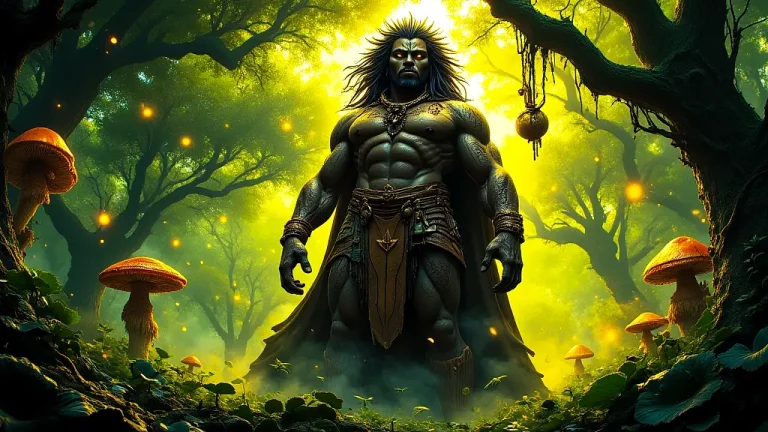Hesperides: Greek Nymphs Of The Evening And Golden Apples
In the wide world of Greek myths, the Hesperides come across as mysterious nymphs who connect with the evening and a place of magical golden apples. These myth figures catch our attention in different stories that say they are related differently – maybe daughters of Atlas, the big Titan holding up the sky, or from Nyx, the first goddess of night.
Key Points:
- The Hesperides are Greek evening nymphs with ties to golden apples and are often seen as daughters of Atlas or Nyx.
- They guard the golden apples in a magical garden, with the famous apples given by Hera, meaning beauty and wealth.
- Common names include Aegle, Erytheia, Hespera, and Arethusa, which allude to their evening and nature-related significance.
- The golden apples, a sign of endless life, appear in Heracles‘ myths, especially his Eleventh Labor.
- Located at the world’s edge near the Atlas Mountains or beyond Oceanus, their garden is an emblem of a perfect paradise.
- In comparison, similar figures appear in other myths, like Norse Idunn, with different cultural twists.
- Key ideas around them include beauty and protection, representing evening changes and divine gifts that never end.
The Hesperides myth, just like other Greek myths, comes together with differences and viewpoints. This means the varied way of old stories. Think of the Hesperides like stars in the sky; every nymph has her own way but becomes part of the bigger myth, just like stars making a group in the night sky.
Here begins your look into their interesting world – stories where the forever night meets the idea of golden riches, and a way to see how these figures mean different things in different cultures.
Hesperides: Overview and Key Facts
| Aspect | Details |
|---|---|
| Name Origin | Comes from Greek “Hesperos,” which means evening. |
| Family Background | Different stories: They are Atlas’s children or they belong to Nyx, the Night. |
| Main Role | They guard the Garden. They keep the golden apples safe that were given by Hera. |
| Number | It can be three, four, or seven, depending on who tells the story. |
| Names You Hear Often | Aegle, Erytheia, Hespera, and Arethusa appear in many stories as their names. |
| What They Stand For | Evening beauty, wealth, and secured treasures. |
| Myths They Are Involved In | In particular, the Eleventh Labor of Heracles, when this hero must take golden apples. |
| Link to Hera | Hera told them to guard the special apples that make gods live forever. |
| Where They Live | A perfect garden at the world’s far western edge, it’s thought to be at the Atlas mountains, maybe beyond Oceanus. |
| How They Relate to Culture | Impacted later books and art, showing an example of a magical garden and godly watching over. |
Who Really Are The Hesperides?
To actually get the fascinating background of the Hesperides and the unusual stories about them, we need to look more into their starting points. We should also see the stories that explain their puzzlements.
The Beginnings of the Hesperides
The beginnings of the Hesperides start deep in Greek myths, where different stories say they are divine beings from various mythical parents. Hesiod, a Greek poet, says they often appear as daughters of Nyx, the mysterious night goddess. This connection gives them a mysterious feel, like the evening star. Yet another story says they come from Atlas, the Titan who holds the sky.
This links them to great strength, much like the tough lands of the far west, where they live. What’s more, these different beginnings mean the many-sided and sometimes mixed-up nature of Greek myths, where a character’s family means how they’re seen in myths.

In stories, the Hesperides are known because they nurture divine beauty and protect the golden apples that give immortality. Their names are many, with different stories including:
- Aegle: Talks about light and splendor.
- Erytheia: Refers to the red shades of sunset.
- Hespera: Links directly to evening.
- Arethusa: Sometimes counted among them, also a naiad in other tales.
These names mean their roles and personalities and offer a way to understand the ancient Greek view of nature. Each nymph appears as a sign of twilight or evening beauty, captivating those who shared these stories long ago.
The Hesperides, linked to different mythical origins, are pictured in Greek myths as enchanting protectors of golden apples and embody the beauty of twilight through their diverse character profiles.
Taking a Peek at the Hesperides’ Garden
The Garden of the Hesperides, described as a place with heavenly beauty and mystery, lies at the world’s far western edge, which fits with the myth of the sun setting. People sometimes call this garden the gods’ orchard. Ancient texts describe it clearly with green trees and a pleasant, otherworldly climate. And it’s known for keeping the famous golden apples that give gods’ favor and everlasting life to the privileged.
These special apples grow in plenty here, making the garden a sign of divine favor and youth forever. It’s very much like a mysterious Eden full of nature and treasures that are jealously kept safe. Moreover, Greek stories say different things about where the garden sits and what it holds, noting its mythical feel.
One theory says it is beyond the Oceanus, that river thought to go around the world. Another suggests near the Atlas Mountains in today’s North Africa, always under protection by nature and the Hesperides’ watchful eyes. An interesting aspect is the dragon Ladon, a serpent meant to keep the apples from those who shouldn’t take them.
This guardian, always watching, gives extra mythical depth, making the garden both tempting and risky. It’s a bit like an ancient story of a fortress full of amazing riches, guarded by strange beasts.
These stories are seen in this table of main features from different myths:
| Feature | Descriptions and Sources |
|---|---|
| Location | Near Atlas Mountains or beyond Oceanus |
| Guardian | Ladon, the dragon, ensuring protection of the golden apples |
| Distinguishing Landmark | Golden apple trees Hera granted |
| Attributes | Called beautiful, rich, and always green, often linked to evening and sunset |
| Representation | Means never-ending beauty and life, like a paradise on Earth |
This detailed layout not only explains what the garden looks like but also tells the important myth stories about it, pointing out the rolling theme of searching for the unreachable, a theme that goes deep into literature and oral stories through history.
What’s Up with the Golden Apples?
In Greek myths, which are very complex, the golden apples of the Hesperides mean more than the dream of endless life. They mean a strong sign of godly support given by the goddess Hera. These special fruits have a strange shine and were not just any apples.
They were thought to give endless life to those who could taste them, a fascinating idea heard in many myths. Their origin is heavenly, so they link directly to the Hesperides, who have the important job of keeping these golden apples safe in their beautiful garden.
The goddess gave them this duty, showing the critical part the Hesperides play as keepers of these valuable gifts. Knowing the Greek gods’ thoughts about life and death, the golden apples can be compared to the Holy Grail from Arthurian stories – an object of ultimate power and a gift from the gods.
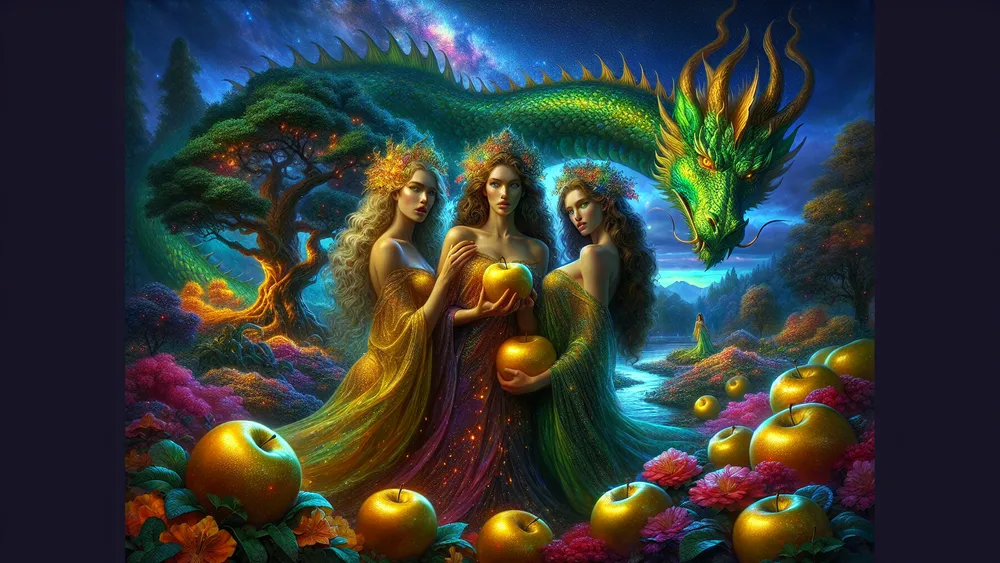
These apples stand for not just the appealing idea of endless life but also the complex connection between gods and humans. The golden apples were displayed in the well-known Eleventh Labor of Heracles, a story that highlights their key place in Greek tales. Heracles had to get these apples because King Eurystheus told him, so he went on a dangerous journey.
It was not just about grabbing the apples; it also involved getting past the dragon Ladon and rolling through tough meetings with other mythical characters, even meeting the Titan Atlas. This labor, one of twelve, is special because it tells about being smart and brave when facing impossible challenges.
This story says the apples are valuable things wanted by both gods and people, putting them up as important parts of heroic storytelling. You could say Heracles’ journey looks like many heroic stories, where getting a famous item is both a real and symbolic act of huge heroism.
Hesperides in Greek Mythology
As we look closely at stories about the Hesperides, we should think about their connections to many important mythological tales and their meetings with other divine beings.
The Story of Heracles’ Eleventh Labor
The Eleventh Labor for Heracles was a hard job about getting the golden apples from the Hesperides’ garden, a mission noted for many details and myths full of depth. King Eurystheus, who assigned these tasks, wanted Heracles to do this difficult job, knowing the garden wasn’t just kept by the Hesperides but a scary dragon named Ladon as well. The garden’s place?
No one really knew, which made Heracles’ trip even more complex. So, he talked to several Greek myth people, getting useful tips. For example, he asked the sea god Nereus, who could change form and knew a lot about the world’s old places. Heracles caught Nereus during one change, making him tell where the garden was, showing Heracles meant to be strategic, like a person finding clues from different sources.
Interestingly, near the garden, Heracles met Atlas, rolling under the weight of the heavens. Cleverly, Heracles offered a trade – stand for the heavens a while if Atlas brings the apples. Atlas, keen to drop his endless weight for a bit, agreed and got the apples from his daughters, the Hesperides, avoiding Ladon and moving into the sacred garden.
But then, when Atlas seemed to not want his sky weight back, Heracles, smart as ever, used a trick. He got Atlas to take the sky again by pretending to want a shoulder pad for comfort, ending up free with the apples, showing how smart moves, more than his strength, were often Heracles’ way.
Some stories tell it differently, where Heracles, known for being strong, met Ladon right away, defeating the dragon himself. This view highlights another part of Heracles’ character – his clear ability to face and beat tough enemies, marking him as a true hero doing the impossible.
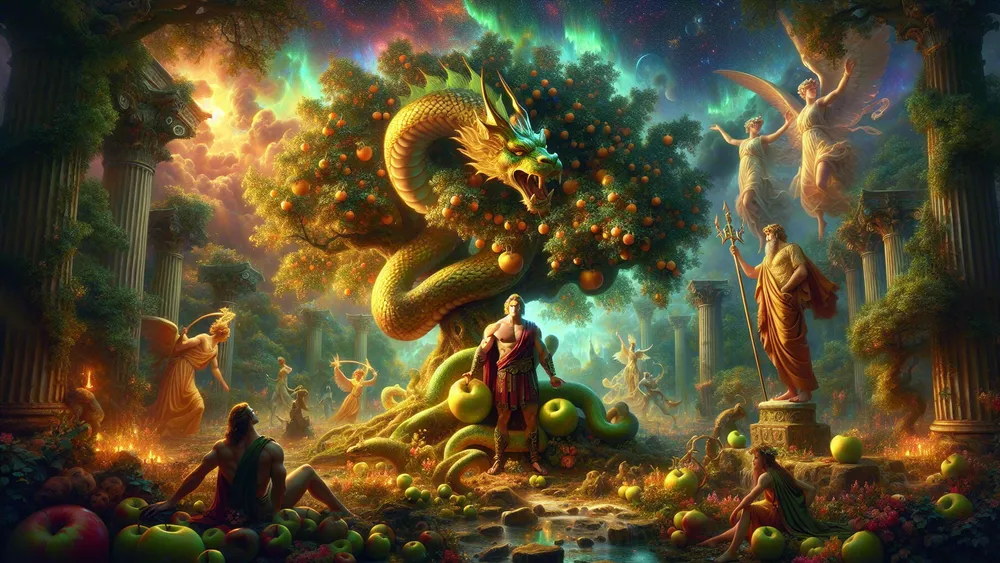
The different stories show the apples’ draw and their challenges, reminding us of the mixed themes in this job. Heracles’ return with the apples meant his win, meaning he could adapt, plan, and win his giant twelve labors, each showing hard work and success.
How the Hesperides Connect with Other Gods
The Hesperides, known well as the nymphs of the evening and keepers of the golden apples, have important ties with the group of Greek gods, with the goddess Hera sponsoring them. Hera, who is queen of the gods and Zeus’s wife, gave the Hesperides a key role: to guard the apples that meant godly endless life and faithful marriage.
The apples meant as a wedding present from Gaia to Hera, showing the sacredness of marriage, rooted the Hesperides deep in Hera’s world. Interestingly, they are often linked to Titan Atlas as their father, placing them within the bigger godly family, showing their middle position between stories of Heracles and the gods.
Their garden was so important that it drew Heracles and even involved sea gods like Nereus in Heracles’ adventure. This highlights how the Hesperides’ job and ties spread through various myth tales, like being keepers of an essential object in a family of gods.
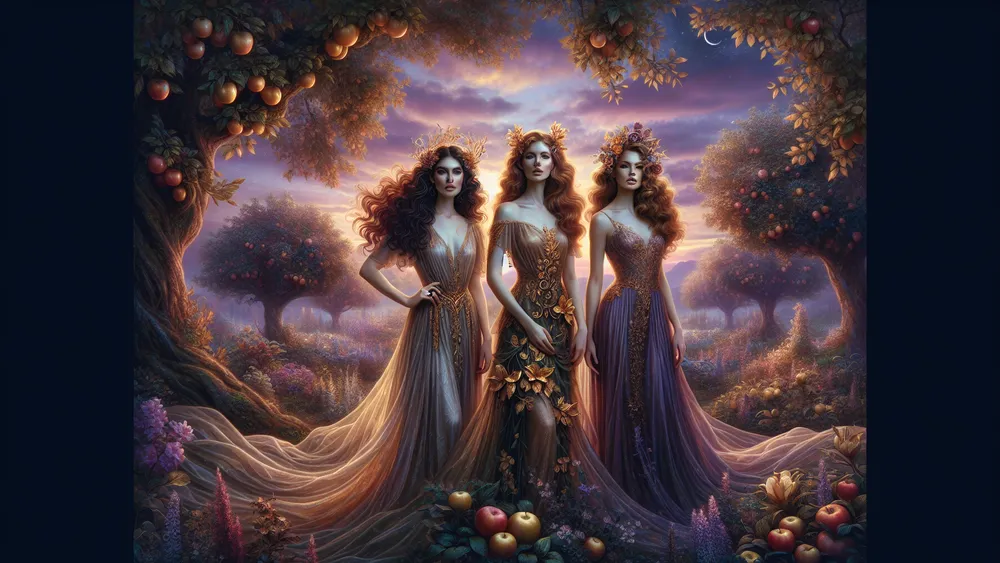
The Hesperides, guarded golden apples gifted by Gaia to Hera, linking them to key myths and the family of gods.
What Do the Hesperides Stand For?
In old Greek myths, the Hesperides were all about different ideas, holding thoughts of beauty, short-lived moments, and the passing day at sunset. These magical nymphs, who often looked very nice, stood for the perfect beauty that Greek art valued, like sources for artists in art history.
As keepers of the godly garden with the golden apples, they meant caring for and looking after important godly gifts, bringing up ideas of watching over things and keeping them safe. This job showed how much the old Greeks respected nature as both a caring force and something needing protection, creating a duty toward what they found sacred.
The evening was linked to them, and living at the edge of the world, the Hesperides meant the movements of time – every sunset turning into night, a clear idea matched with life’s own ups and downs.
The ideas about the Hesperides can be simplified to a few main themes that perfectly capture their cultural and mysterious importance:
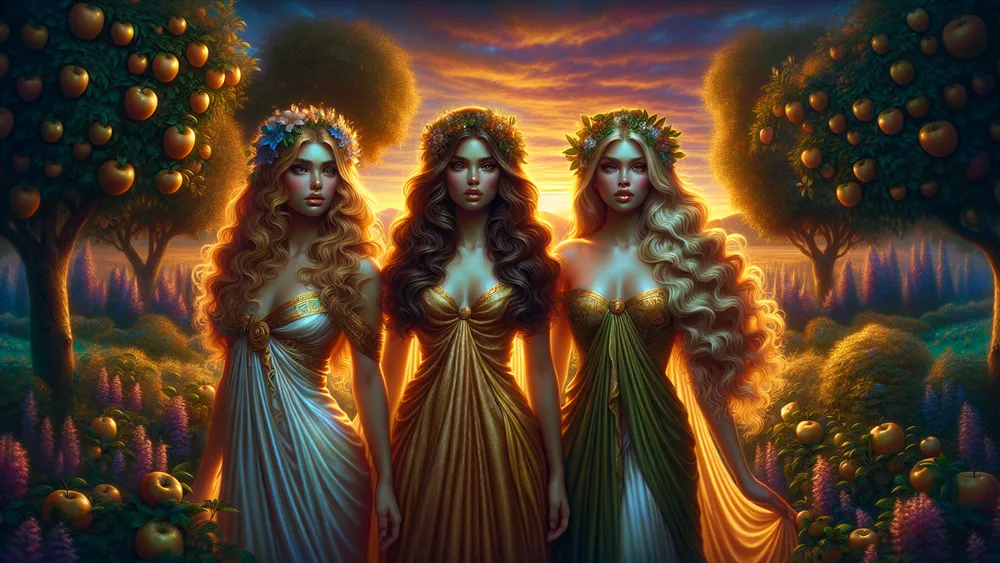
- Beauty: They meant pure and natural beauty, which artists and writers liked.
- Guardianship: They were about looking out for the golden apples, meaning awareness and duty over important things.
- Evening Nymphs: Their link to dusk and the western sky meant change and time’s ongoing cycle.
- Divine Treasures: The golden apples they guarded were more than just fruit but symbols of godly favor and living forever.
Therefore, this several-layered symbolism made the Hesperides a lasting and powerful part of Greek myths, giving insights into the values and deeper thinking of the old times.
Roman and Other Mythological Equivalents
Further, if we move past the boundaries of Greek mythology, it’s interesting to look at how the idea of the Hesperides fits in with Roman traditions and other mythological frameworks.
How Do the Romans See the Hesperides?
In Roman stories, there is a detailed look at the Greek Hesperides, but they didn’t have an exact match. Roman writers put Greek stories into their own godly group, sometimes keeping the main idea while changing details to fit Roman ideas.
The interest in the golden apples still appeared in Roman tales, often represented by ‘aurea mala,’ but the focus was more on general nymph-like figures and keeping up mythical gardens, rather than having specific Roman versions like the Hesperides.
Interestingly, this is like seeing a new version of a classic film where the main story is still there, yet characters and settings might change for new themes. Romans took Greek myths and adjusted them. The continuity is important, but they made changes, just like setting a play to match the current times.
Comparing with Norse and Egyptian Myths
In Norse mythology, Idunn is like the Hesperides. They have her looking after apples that let the gods live forever, similar to how the Hesperides guard their golden apples in a heavenly garden. But she’s not like a group of them – she’s a single goddess in the main part of the Norse world. Her role was important. Really very important.
Groups compared to one person, this is how their tasks appear. In Egyptian mythology, though equivalents almost don’t exist due to Egyptian cosmology, there are still similarities – like Hathor or Isis. They are seen as having traits of strength and beauty. Egyptian goddesses, often present everywhere, have significant roles covering all parts of life including the afterlife.
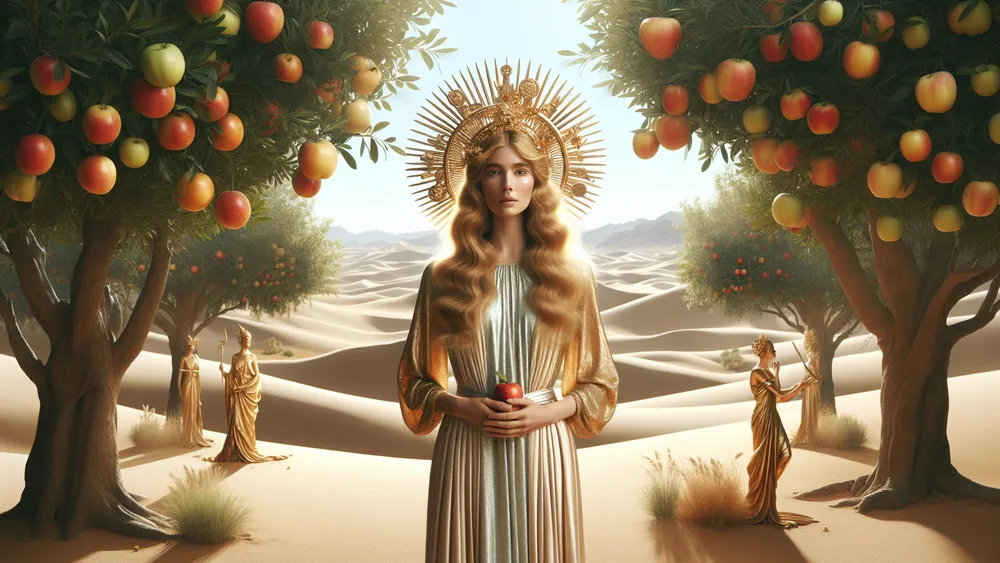
It is not about one place or item but a view over life and death, showing how geographic and cultural differences shape these myths.
Pantheon of Greek Mythology Creatures
Greek mythology is known for its mix of magical creatures and scary monsters. Each has important parts in stories and means different things, from chaos or danger to wisdom. The Chimera, which is strong, and the dangerous Minotaur. Also Pegasus, who never dies, and the clever Sphinx, each remind you of characters from fantasy books. They captivate you. Discover the many of these mythical beings and their meaning.
You can see a detailed list of all the Greek Creatures and Monsters. This list shows the hundred-headed dragon Typhon and also the Sirens. It lets you see the wide variety of Greek myths.
FAQs
1. Who were the parents of the Hesperides?
The parents of the Hesperides vary across Greek myths, with some versions naming Atlas and Hesperis as their parents, while others attribute their parentage to Nyx.
2. What is the significance of the golden apples?
The significance of the golden apples lies in their representation of immortality and divine favor, making them central to myths like Heracles’ Eleventh Labor.
3. How did Heracles complete his Eleventh Labor?
Heracles completed his Eleventh Labor by enlisting the help of Atlas to retrieve the golden apples while he held up the sky in Atlas’s stead.
4. Are there parallels of Hesperides in other mythologies?
Par allels of the Hesperides in other mythologies include entities such as the Norse Idunn and her golden apples, and Egyptian goddesses tied to fertility and nature, though these figures have distinct contexts and characteristics.







